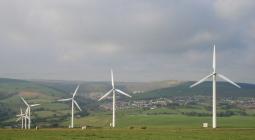Scotland Could Leave the United Kingdom Over Brexit—and Green Energy.

The debate over how to best marshal the country's alternative energy sources may affect a new independence referendum.
EDINBURGH, Scotland—Five years ago, when Scotland voted in a landmark referendum to remain part of the United Kingdom, the issue of North Sea oil—who owns it and how it should be administered—was a key feature of the Scottish National Party’s (SNP) independence platform. If—as seems increasingly likely in the context of Britain’s ongoing scramble over Brexit—Scots vote again in the coming years on the future of their union with England, the heavy winds and tides that buffet Scotland’s coastline will play an equally critical role in the next campaign.
By some estimates, Scotland has 25 percent of Europe’s total offshore wind and tidal resources and around 60 percent of the U.K.’s onshore wind capacity. Renewable energy is worth nearly 6 billion pounds (about $7.5 billion) annually to the Scottish economy—and green electricity exports are rising every year. But in the face of an accelerating global ecological crisis, both advocates and opponents of Scottish independence think the country can go further in embracing alternative energy sources—they simply disagree on whether Scottish independence would help or hurt that goal.
Nationalists, led by SNP chief and Scottish First Minister Nicola Sturgeon, argue that an independent Scotland could become a pioneer of clean energy production, transforming the Scottish economy as oil might have done in the 1970s and 1980s, after it was first discovered beneath the waters near Aberdeen. Unionists contend that Scotland’s green energy industry can only flourish through sustained cooperation with the rest of the U.K.
“Nearly 80 percent of our electricity now comes from renewables, but with independence we could do much more,” Tom Wills, a renewable energy specialist who stood, unsuccessfully, for the SNP in a recent Shetland Islands by-election, told me when we spoke in September. “With control of energy policy, we could play to our strengths as a country, for example by taking strategic decisions to expand our electricity grid.” Wills added that the U.K. lacked a “coherent” industrial strategy for Scottish renewables and pointed to the success of other small European countries, such as Denmark, as evidence that Scotland’s green potential has been stymied by the failure of successive U.K. governments to properly invest. “In the 1970s, Britain had an early lead in wind power, but when the oil price dropped it pulled back and lost out to other nations,” he said.
The environmental case for Scottish independence has only been bolstered in recent years by a series of Parliament-imposed cuts to the U.K. renewables sector. After the Conservatives came to power in 2010, ministers began slashing state funding for green energy projects as part of a broader push to eliminate Britain’s budget deficit. Government subsidies for onshore wind power, support for large-scale solar installations, and tax incentives to boost electric car ownership were all scrapped or scaled back under consecutive Tory governments. Meanwhile, figures released last year show that investment in U.K. clean energy fell by 56 percent in 2017, although this drop appears to have been less pronounced in Scotland, where Holyrood, Scotland’s devolved national parliament in Edinburgh, hasn’t withdrawn support for the sector.
Independence campaigners cite these trends as evidence that London can’t be trusted to be a steward of Scotland’s renewable resources or steer Scotland away from carbon dependency as the threat from global warming intensifies. But supporters of the union insist that the success of Scotland’s green energy sector actually depends on its continued access to Britain’s single, unified energy market—and on the U.K.’s ability to project its influence on the world stage. Those advantages would be squandered if Scotland voted to leave the union, they say, robbing the country of Britain’s broader fiscal shoulders and, possibly, saddling Scottish taxpayers with an estimated multibillion-pound bill for North Sea rig decommissioning.
“[Not] being part of that bigger network would certainly change the way Scotland could act when it comes to energy,” said Danielle Rowley, the member of parliament in Britain’s Parliament for Midlothian, Scotland, and the Labour Party’s shadow minister for climate justice and green jobs. “The U.K. is a member of the U.N. Security Council and the World Bank. Climate change is one of those issues where, undoubtedly, having a bigger voice is more useful.”
The Scottish Parliament doesn’t currently have jurisdiction over North Sea oil and gas licensing agreements, and most aspects of Scottish energy policy remain reserved to Westminster. But that would change with independence. “At which point, you have to make the choice: Do you want this industry to continue or not?” said Ross Greer, a member of the Scottish Parliament for the Green Party, when we met at his Holyrood office recently.
The SNP, now 12 years into power at Holyrood, has attempted to position Scotland as a world leader on climate change. Unveiling her government program at the start of September, Sturgeon set out plans for a “Scottish Green Deal,” facilitated by a 3 billion pound ($3.8 billion) green investment portfolio and a newly minted Scottish National Investment Bank. The “primary mission” of these programs will be to “[secure] the transition to a net-zero economy,” the SNP leader said. Weeks later, the Scottish Parliament voted to raise Scotland’s official emissions reduction targets from 70 percent by 2030 to 75 percent, and to reach the zero-carbon threshold by 2045.
But Sturgeon’s apparent radicalism on the environment has been matched by the U.K.’s Labour Party, which has pledged to oversee a multibillion-pound “Green Industrial Revolution”—an initiative the party says would create thousands of “good green jobs” throughout the country, including in Scotland—and to implement one of the most ambitious decarbonization plans anywhere in Europe. At the party’s conference in Brighton last month, delegates voted in favor of decarbonizing the British economy by 2030—a goal that would be achieved through “massive investment in infrastructure and skills [and] public ownership of key utilities,” a Labour spokesperson confirmed after the conference vote.
Sturgeon hasn’t responded directly to Labour’s proposals, but she continues to insist that independence, which would significantly expand the taxation and spending powers of the Scottish Parliament, is a necessary step in Scotland’s fight against climate change.
According to Laurie Macfarlane, an Edinburgh-based economist who advised Sturgeon’s administration on the creation of the Scottish National Investment Bank, British business is systemically failing to provide the investment needed to fund Scottish green infrastructure projects. If Scotland’s transition to a low-carbon economy is going to happen anytime soon, the process “needs to be driven by the state, from the public sector,” he said.
“Crucially, whether Scotland is inside or outside of the U.K., the success of a public-led approach depends on the willingness of political leaders to fund initiatives using the powers of the public purse,” he added. “The state must act as the investor of first resort, not just the lender of last resort.”
Yet there are growing concerns about the extent to which ordinary Scots—many of whom have been hit hard by a decade of austerity and flatlining wages inside the U.K.—will benefit from Scotland’s embrace of the renewables revolution. Under both the SNP at Holyrood and the Tories at Westminster, sizable chunks of Scotland’s burgeoning green infrastructure have already been sold off to companies based in other countries.
The Neart na Gaoithe wind farm in Fife, for instance, is run by a subsidiary of the French energy giant EDF, which hired workers in Indonesia to build the sleeves for its offshore turbines over a local Scottish firm, BiFab. And turbine construction for the Moray East wind farm, located off the coast of Caithness, is being bankrolled by a consortium of firms from Portugal, France, and Japan, while the turbine blades are being manufactured by a Danish company, MHI Vestas Offshore Wind.
The outsourcing of Scotland’s renewable assets represents “a failure of industrial policy that means workers, businesses and Government in Scotland do not benefit from Scotland’s natural resources,” areport by the Scottish Trades Union Congress stated in April. Although the trade union umbrella group remains neutral on the question of independence, it has called for an increase in the remit of the Scottish Parliament—and of the nascent Scottish National Investment Bank—to help seize the prospective economic advantages of Scotland’s green energy sector. “While the Scottish Government’s monetary powers are limited, their plans for a Scottish National Investment Bank provide an opportunity for public investment to build and capture value from the [low-carbon and renewable energy] economy,” the report from April continued. “However current proposals are far too timid given they do not include: full borrowing powers, the ability to lend to the public sector, or a built-in focus on climate change, inequality, and fair work.”
The problem for Sturgeon is that any attempt to unite her political allies around energy issues in advance of another referendum is likely to fail: The independence movement itself is split over the speed and scale of Scotland’s shift toward decarbonization. The Scottish Greens, who campaigned vigorously for a “Yes” vote in the September 2014 independence referendum, argue that the SNP’s ongoing commitment to a policy of so-called maximum economic extraction from the North Sea fundamentally undermines Scotland’s reputation as a global leader on the climate. They believe the vast majority of remaining North Sea oil and gas reserves—which experts say could stretch on for another 20 or 30 years—need to stay buried, forever, if Scotland is going to meet its carbon reduction targets over the coming decades. Sturgeon has so far resisted these calls but has said that future Scottish government support for North Sea fossil fuels will be “conditional on the sector’s actions to help ensure a sustainable energy transition.”
Whether or not a new referendum results in independence, in the absence of proper strategic planning, there is a risk that Scotland could forfeit the economic advantages of green energy in the 21st century just as it missed out on the full potential of its oil wealth in the 20th. In the 1970s, when the SNP was enjoying its first blush of electoral success, the party wanted an independent Scotland to assert a public stake in North Sea fields and use tax revenues from oil production to build a Nordic-style sovereign wealth fund. Ultimately, the nationalist insurgency fizzled, and North Sea levies continued flowing south to London, resulting in a 300 billion pound bonanza for the U.K. Treasury, about $375 billion, over the following four decades. Some economists believe that, had Scotland followed Norway’s lead by embracing independence and investing its oil profits strategically, it could have built a wealth fund of its own worth upward of 450 billion pounds, about $565 billion. Instead, nationalists argue, Scotland experienced years of cuts and privatization, often enacted by U.K. governments with scant support north of the Anglo-Scottish border.
Nicola Sturgeon seems determined to stage another referendum on Scottish independence soon—possibly even during the second half of 2020. If she gets her way, delegates to the United Nations’ next major climate summit—slated to take place in Glasgow in late 2020—might get to see, firsthand, how Scottish politicians reconcile rising demands for national sovereignty and economic control in the era of environmental breakdown. The challenge for Sturgeon’s SNP is to persuade a majority of Scottish voters that they are—or could be—the most effective custodians of their own lavish natural resources.
14 October 2019
FP





